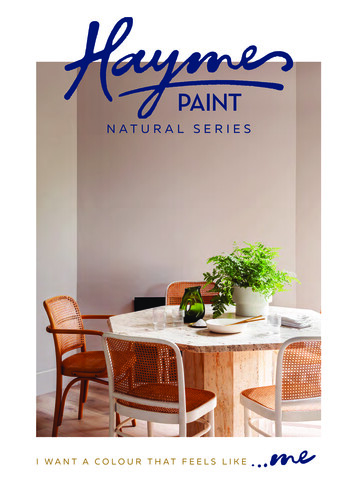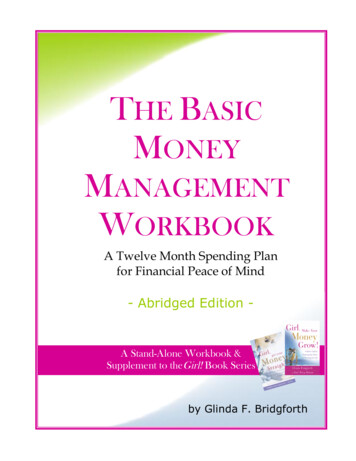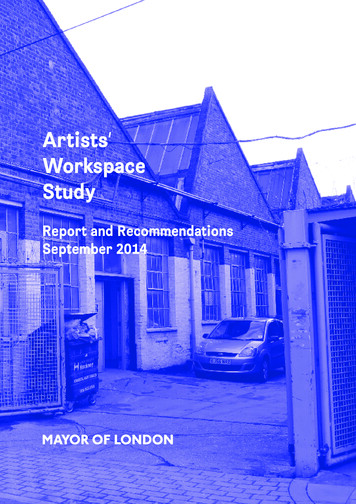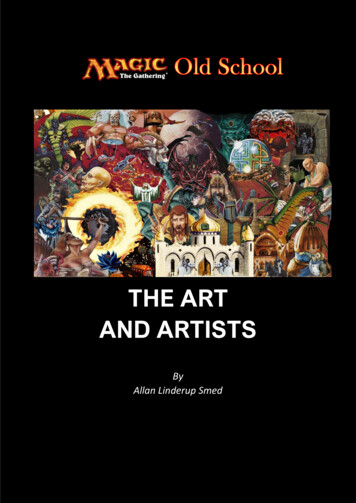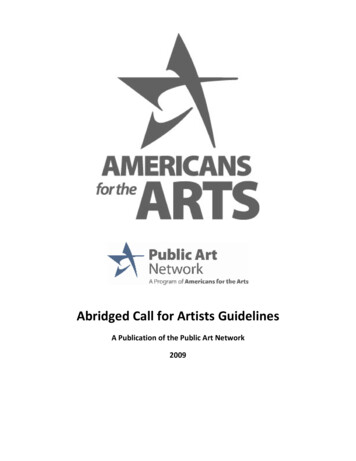
Transcription
Abridged Call for Artists GuidelinesA Publication of the Public Art Network2009
ContentsWhat is a Call for Artists?Call Elements: Definitions and DescriptionsGetting the Word Out: Where to Advertise Your Call for ArtistsSample Request for Qualifications (RFQ)Sample Request for Proposals (RFP)Whether your public art program has been writing calls for artists for years or your organization is justgetting started with commissioning public art, the Call for Artists Resource Guide contains informationthat will help you announce opportunities that clearly describe your projects and give artists theinformation they need to submit applications.The Call for Artists Resource Guide was originally developed by the Public Art Network (PAN), aprogram of Americans for the Arts in 2003 and is updated herein. PAN provides services to the diversefield of public art develops strategies and tools based on best practices to improve communities throughpublic art. Its key constituents are public art professionals, visual artists, design professionals, as wellas communities and organizations planning public art projects and programs.Copies of this resource guide may be downloaded free of charge on the Public Art Network section ofthe Americans for the Arts website, www.Americansforthearts.org/PAN.For more information about PAN or Americans for the Arts, email pan@artsusa.org or visitwww.Americansforthearts.org/PAN.
What is a Call for Artists?Public art programs and organizations commissioning public art projects enlist artists to be consideredfor their projects in a variety of ways. These include calls for artists, juried slide registries, and directinvitations. On-line calls for artists have grown in use over the past few years and represent asignificant cost savings for both artists and organizations using the on-line submittal and review ofartists’ credentials.A Call for Artists is an opportunity notice that gives artists the information they need to know in orderto apply to be considered for the project. Issuing a Call for Artists is a standard practice of the publicart field.There are currently over (#) public art programs in the United States. They can be rural or urban;government agencies based in municipalities, counties or states; or private nonprofit or for-profitorganizations run independently or as part of a local arts agency.Types of CallsThere are two traditional types of Calls for Artists: Requests for Qualifications (RFQ) and Requests forProposals (RFP). Current best practices supported by PAN endorse payment to the artist for anycreative work related to the development of a concept, so that an RFP specifically and routinelyincorporates a fee for the artist in addition to the reimbursement of travel expenses. There has beendiscussion within the field of public art about the appropriateness of RFPs versus RFQs, including thepossibility that a Call for Artists may include a request for brief comment (rather than a full proposal)on the artist’s approach to the project. PAN’s issue paper, Methods of Artist Selection: best Practices,discusses this topic online at www.AmericansfortheArts.org/PAN.All versions of Calls for Artists can take place on-line and can use one method or a combinationthereof. Variations include open or limited competitions, invitationals, or direct purchases. An opencompetition is broadly promoted to encourage numerous applicants; a limited competition is directed toa specific group of artists, sometimes narrowed by discipline, often by geographic location (only thestate of ) On occasion the size of the project budget for art dictates limiting the reach of a call and theselection process to direct purchase.It is less costly for artists to digitally document their art and respond to on-line calls for artists. Thecost of the review process is borne by the agency sponsoring the call for artists.An RFQ invites artists to send their qualifications to be reviewed by the selection panel but does notrequire a specific proposal to be submitted. RFQs are used to choose artists based on their past andcurrent art and achievements.
Before an artist or artists begin their research to develop a proposal or proposals – their ideas – they areplaced under contract and paid to work on the project.Organizations use RFPs when they choose to work with a small pool of artists, or a single artist, basedon their qualifications, to develop a detailed proposal for the site or project based on limited exposureto the project. An RFP does not guarantee the artist(s) will be selected to implement their ideas orproposed art but PAN advocates that each artist is paid a stipend and travel expenses for proposaldevelopment and presentation, beyond a request for a brief comment on the artist’s initial thoughts onan approach to the commission. Some governmental regulations require the solicitation of proposalsfor selection and prior to contracting for implementation of a proposal.Selection committees using RFPs willingly spend proposal funds upfront to be able to review a fewproposals prior to selecting an artist to work on a project from design development through installationand dedication.
Call Elements: Definitions and DescriptionsBelow is a list of content typically found in a Call for Artists, with advice on how to clearly conveyyour information.Call SummaryA brief project summary.The Call Summary helps artists quickly decide whether they are interested or eligible for the call andlets organizations posting the call decide how it should be promoted. Include the project name,commissioning organization, application deadline, project timeline, budget, geographic eligibilityrequirements, and whether it is an RFQ or RFP.Project DescriptionAn overview of the artist’s scope of servicesDiscuss whether it is a design-team project, a commission of new work, integrated art, functional artreplacing functional items, a master plan, an artist residency, a purchase of existing art, or another typeof opportunity. Include a description of the organization overseeing the project.Art goals or criteriaA list of any predetermined objectives for the art established by the commissioning organization,funder, or community.The specificity of list will vary by commissioning organization and to reflect the characteristics ofeach project.The list can be broad – e.g., create a sense of place within the community – or specific – e.g., designstreetscape elements that reflect the industrial history of the neighborhood.Art Location DescriptionA description of where the art will be within the project site.Sometimes the location for art is predetermined by the funder, commissioning organization, orcommunity before a Call for Artists is distributed. If this applies to your project, provide a highlydetailed description of where the art will be located within the site, especially for an RFP. Thedescription should include, but not be limited to:
Engineering and architectural information about the location’s structure, materials used at the location,visibility within the site, and lighting information.If the art location is not predetermined, state whether or not the artist will be free to participate inselecting the art site.Site or Art Location PlansPlans, photographs, or other visual information of the site or art location.Describe the site’s function, include what activities will happen there and who uses it. Be sure toinclude whether or not the site is open to the public, or if the public can see but not enter the site.Include a description or history of the site and community where the art will be and list additionalresources for the artist to research.BudgetThe amount of funding allocated to art for the project.Clearly state the budget for art and what is expected to be covered (not all projects have the sameexpectations of project costs covered by the art budget).For instance, in a design-team project, the budget may include only the costs of artists’ fees and travel.In the commissioning of art, project costs may include the artist’s fee, travel, engineering, materials,fabrication, transportation, documentation, and oversight of installation but not actual installation costs.Often costs for insurance, taxes, studio overhead, and miscellaneous items are not included in anartist’s budget by the artist or commissioning agency. It should be clear from the beginning whichcosts may legitimately be included in the artist’s budget and which are covered by others.Finally, in some cases an actual art or project budget has not been set at the time an artist is selected. Itis important to determine the amount that is secured for the project and art and what has to be raised torealize each.Artist EligibilityThe qualifications that an artist must meet in order to be eligible for a project.Questions to consider include:Must the artist live/work in a certain geographic area or is the call open to artists nationally?Is the call open to professional artists or are students eligible?
Are artist teams eligible for the project?Must the artist have completed a project with a similar budget, scale, and scope?If you are seeking to reach out to certain types of artists, include a sentence encouraging artists thatmeet those objectives to apply. For example, if the commissioning organization is seeking to reach outto emerging artists, include a statement such as “professional artists who are new to the field of publicart are encouraged to apply.” Or if the project is one that will involve a high level of communityinteraction in a specific setting, include a statement such as “artists who have experience interactingwith community are encouraged to apply.”This is also the place to include an equal opportunity statement that may be required by thecommissioning organization, local municipality, funder, or owner.Application RequirementsThe list of materials artists should send by mail or online with their applications.Be very specific about the information artists should include with their application since it determineshow it is presented to the panel reviewing applicants and selecting artists.Typical application requirements include:Number and type of visuals (on-line should include exact dpietc(Isn’t this section redundant with paragraph below starting “Visual support materials ?)Annotated listsStatement of interest (often restricted to number of words)Resume or short biographySelf-addressed stamped envelope (SASE) for the return of hardcopy materialsProject proposal (for RFPs)Visual support materials can include digital images in exact formats, slides, videos, CDs, or prints. Ifrequesting digital images or slides, list the number of images artists may submit and how they shouldbe labeled. If a panel is reviewing digital images, CDs or video, in addition to the number of images bespecific about length of time for moving images and the formats the panel will be capable of viewing.If prints are solicited, list the number of prints the artist is to include. (Should power points bementioned specifically?)The annotated list allows the artist to describe the visual support material and usually includes:description, material, location, budget, client or commissioning organization, and any other relevantproject information.
The statement of interest allows artists to introduce themselves and describe their specific interest in aproject, their potential approach to the project or creating public art, and any past relevant experience.If there is a specific question you would like the artist to address in the statement, be sure to include itin the Call for Artists.If artist teams may apply, clearly state if you require additional visual support materials, resume, andreferences for each team member.If you are inviting and paying artists to develop proposals, clearly list the types of materials you wouldlike the artist to submit to best present their work to the review panel. Typical proposal submissionmaterials include: project description, drawings, renderings, model, photographs, materials list, budget,timeline, references, fabrication, installation, and maintenance information.DeadlineThe date when an application must be either received or postmarked.List the date by which an application must be either received at the mailing or on-line address orpostmarked. Be sure to state if overnight or express delivery is NOT permitted.Submission AddressThe address to which application is submitted or mailed.Include the online address or mailing address. If overnight or express shipping is allowed, be sure thatthe address is not a post office box or supply an alternate address for this type of delivery. If only online submissions are acceptable, clearly state that there will be no mailed submissions accepted.Selection ProcessA description of how the applications will be reviewed and an artist selected.Include the types of people who are on the selection panel, e.g., art professionals, communityrepresentatives, agency representatives, and funders. Include the number, or range, of finalists that willbe selected and what will be required of the finalists, including interviews, proposals, dates forpresentations, and travel.If finalists are subject to interview, state if a fee and travel expenses are covered as well as timeline forinterviews and who will participate in the interview process and make the final artist selection.If proposals are required, provide artists with information about what is included in a proposal,timeline, budget, etc., and fee for proposal, travel, and presentation, and decision-making schedule.
Selection CriteriaA list of the criteria established by the commissioning agency or artist selection panel that will guidethe evaluation of applications.Listing the selection criteria establishes the priorities of the artist selection panel. The list also assistartists when considering whether they should apply for a project. For example, if the criteria for theRFQ includes artistic excellence, evidence of working in the field of public art for more than five years,and experience working in community settings, artists new to public art will be informed that theirqualifications are not a good fit for the project.Project TimelineThe timeline the project will follow from artist selection to project completionThe timeline includes dates for the following milestones, as they apply:Submission deadline, panel review, finalist notification, interview schedule, proposal presentations,final artist selection, contract, design review phases, fabrication and installation schedule for artcoordinated with project construction, and completion date.Sources for Additional InformationA list of resources the artist may consult for additional project information on the project, site,commissioning organization, community, area history, etc.Providing artists a list of resources they can consult about different aspects of the project can help themdecide if they want to apply and if their work is a good fit with the project parameters. In the case of anRFP, the list can be a launching point for research. Include website addresses, publications, contactinformation for organizations, and other information that would be helpful and relevant to artists asthey research the project.Resources for QuestionsThe contact information for the person or organization to be called if the artist has questions or needsadditional information.Be clear about whether telephone calls or email inquiries are accepted or if questions may only besubmitted by fax or email. Also state if there is a deadline by which questions must be submitted.
Getting the Word Out:Where to Promote Your Call for ArtistsThe Public Art Network suggests the following resources for posting artists opportunities:Public Art Network ListservAvailable to Americans for the Arts/PAN members, this networking tool connects colleagues andactsas a research engine, newsletter, and stage for critical dialogue. Artists opportunities are frequentlyposted on the listserv as well as in the PAN e-mail broadcast. To join, visit:www.Americansforthearts/PAN or e-mail membership@artsusa.org. E-mail pan@artsusa.org to submitopportunities.Public Art ReviewSculpture MagazineNYFA Source/NYFA is list needs updating, checking .)
Sample Request for Qualifications (RFQ)We need to select a recent (excellent) sample Call for ArtistsOne hardcopy and one electronic (CAFÉ?)Suggestions?
Sample Request for Paid Proposals (RFP)A Request for Proposals should include the following elements: Project SummaryAn overview of the history, site, commissioning agency or institution, and goals of the project Profile of commissioning institutionA more detailed overview of the history, character, and mission of the agency that is sponsoring thecommission Site DescriptionAs detailed as possible summary of the site proposed, including size and layout, proposed placement ofwork or integration of work into the site, access, use of the site by the public or audience now and afterthe projected commission, any related planning activities, and the relevant surrounding context for thesite and the work Design CriteriaAll physical and conceptual elements expected in the design program, including the character andexperience of the work, lighting, maintenance, sight lines, andrequired design practices (such assustainability). BudgetIncluding total budget, breakdown of what the budget does and does not include (artist fees,landscaping and/or engineering consultants, site preparation, installation, maintenance, etc.) Proposal Development FeeHonorarium or fee for the artists’ development and preparation of the proposal, as well ascompensation for travel expenses incurred in any site visits agreed upon Project TimelineIncluding dates for site visits, presentation to committee and/or public, committee decision, designdevelopment, construction drawings, permitting, fabrication, installation, and dedication Proposal RequirementsFormats for digital and hard-copy materials, delineation of proposal documents (artist statement ofintent, description of project, concept and approach, proposed schedule or timeline for design andfabrication, budget), site plan or analysis, schematic drawings or sketches, models or CADpresentations, video formats, material and maintenance proposals PresentationDate, time, and location of presentation to committee or agency ContactsNames and contact information for project consultant, commissioning agency or institution, and asappropriate, engineers, managers and consultant involved in the project Lists of documentation and appendices related to the site and the project (included in RFP package oravailable through the commissioning institution and/or the project website or other sources
significant cost savings for both artists and organizations using the on-line submittal and review of artists' credentials. A Call for Artists is an opportunity notice that gives artists the information they need to know in order to apply to be considered for the project. Issuing a Call for Artists is a standard practice of the public art field.
